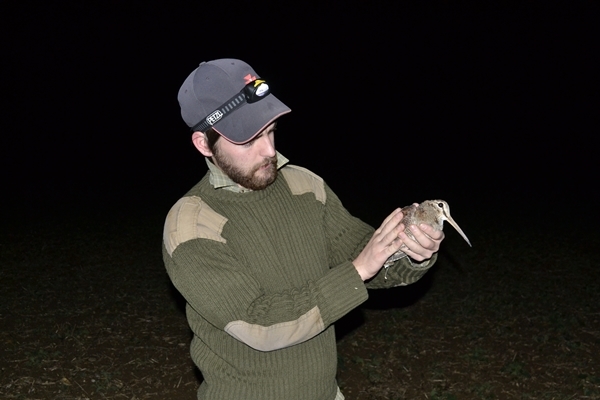
GWCT PhD student Chris Heward tagging a woodcock
BREEDING woodcock are more common in larger, better connected and more varied woodland areas in Britain, a new study has shown.
Researchers looking to understand how management could affect woodcock breeding success have discovered that a mixture of different tree types create an ideal environment for the much-loved wading bird.
Habitat correlates of Eurasian Woodcock Scolopax rusticola abundance in a declining resident populationis a new paper that compares a wide range of different woodland sites across the UK with relation to the number of breeding woodcock present.
Birch trees formed a key part of much of their preferred habitat, possibly because their dense trunks create safe feeding ground and their leaf litter support more earthworms on which woodcock can feed.
The combination of mixed woodland, interspersed with open spaces, provides a variety of habitats for the various stages of the breeding season. This information could help to inform future woodland management advice.
Hundreds of volunteers visited pre-selected woodland sites across the UK and recorded ’roding’ woodcock at dusk during May and June – the period when this unique display behaviour is at its peak.
During the surveys, which were carried out on over 800 sites in 2003 and 2013, volunteers performed woodcock counts and recorded data on the wood’s structure, age and dominant vegetation types.
Woodcock counts were compared with a range of landscape-scale habitat variables, as well as the local habitat measures recorded by surveyors, using generalised linear mixed models.
The paper, written by Game & Wildlife Conservation Trust (GWCT) staff Christopher Heward, Andrew Hoodless and Nicholas Aebischer, as well as scientists from British Trust for Ornithology (BTO) and University of Nottingham, discovered that woodcock were most frequently found in wet woodland areas particularly those containing birch.
Woodcock were less likely to be found at sites dominated by beech. On larger spatial scales, woodcock were more abundant in woods containing a greater mix of woodland habitat types – particularly where broadleaved and coniferous woodlands occurred together.
“The data collected during these two surveys – ten years apart – is intriguing,” said Chris, who is a PhD student at GWCT.
“We are now able to use these points to help guide future research into woodcock, particularly with regards to woodland management for their benefit.”
“We are also tracking individual breeding woodcock to try to understand these effects in more depth and identify woodland management techniques that can be used to help support this iconic species.”
The team also investigated whether woodcock, in these areas, showed any signs of a relationship with roe, fallow and muntjac deer, but the evidence suggests they don’t.
Woodcock, along with many other woodland bird populations, have been in long-term decline.
A previous GWCT study has shown that the number of woodcock that breed in Britain fell by 29% during the same 10-year period. The area in which they breed is also smaller than it was, having dropped by more than half between 1970 and 2010.
Read the paper in full here https://link.springer.com/article/10.1007%2Fs10336-018-1570-z
Notes to editors
The Game & Wildlife Conservation Trust – providing research-led conservation for a thriving countryside. The GWCT is an independent wildlife conservation charity which has carried out scientific research into Britain’s game and wildlife since the 1930s. We advise farmers and landowners on improving wildlife habitats. We employ more than 60 post-doctoral scientists and other research staff with expertise in areas such as birds, insects, mammals, farming, fish and statistics. We undertake our own research as well as projects funded by contract and grant-aid from government and private bodies.
For information, contact:
Eleanor Williams
Telephone: 07592 025476
Email: press@gwct.org.uk